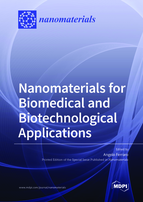Nanomaterials for Biomedical and Biotechnological Applications
A special issue of Nanomaterials (ISSN 2079-4991). This special issue belongs to the section "Biology and Medicines".
Deadline for manuscript submissions: closed (30 October 2021) | Viewed by 61287
Special Issue Editor
Special Issue Information
Dear Colleagues,
There are numerous biotechnological applications of nanomaterials in biomedical and clinic fields as well as industrial processing. Some examples include drug delivery, anti-tumor therapies, stem cell manipulation, genes transfer, separation of biomolecules and ions, biosensors, and biofuel production, among others. The great potential that these applications have in scaling up industrial processing or improving the efficiency and efficacy of medical treatments is becoming increasingly evident. Important aspects for the use of nanomaterials are their synthesis, stability, biocompatibility, and easy manipulation. All these parameters need constant improvement both to reach a high standard of safety and to make them accessible for marketing.
This Special Issue focused on Nanomaterial for Biomedical and Biotechnological Applications will highlight the latest methodologies, protocols, and techniques that employ nanomaterials as the main element for the improvement of biomedical treatments, as well as biotechnological processes.
Dr. Angelo Ferraro
Guest Editor
Manuscript Submission Information
Manuscripts should be submitted online at www.mdpi.com by registering and logging in to this website. Once you are registered, click here to go to the submission form. Manuscripts can be submitted until the deadline. All submissions that pass pre-check are peer-reviewed. Accepted papers will be published continuously in the journal (as soon as accepted) and will be listed together on the special issue website. Research articles, review articles as well as short communications are invited. For planned papers, a title and short abstract (about 100 words) can be sent to the Editorial Office for announcement on this website.
Submitted manuscripts should not have been published previously, nor be under consideration for publication elsewhere (except conference proceedings papers). All manuscripts are thoroughly refereed through a single-blind peer-review process. A guide for authors and other relevant information for submission of manuscripts is available on the Instructions for Authors page. Nanomaterials is an international peer-reviewed open access semimonthly journal published by MDPI.
Please visit the Instructions for Authors page before submitting a manuscript. The Article Processing Charge (APC) for publication in this open access journal is 2900 CHF (Swiss Francs). Submitted papers should be well formatted and use good English. Authors may use MDPI's English editing service prior to publication or during author revisions.
Keywords
- Bio-separation
- Biosensor
- Drug-delivery
- Bioremediation
- Oncology







